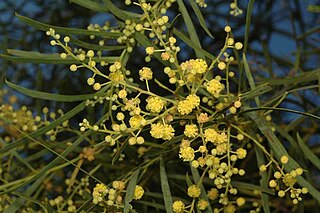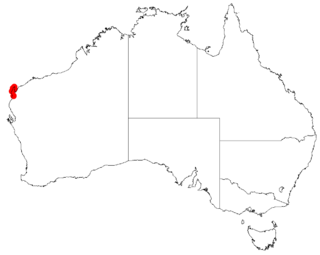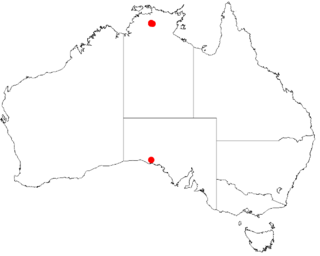
Acacia aspera, commonly known as rough wattle, is a species of flowering plant in the family Fabaceae and is endemic to the south-east of continental Australia. It is an erect or spreading shrub with oblong to narrowly oblong or elliptic phyllodes, one or two spherical heads of cream-coloured to golden-yellow flowers and narrowly oblong pods up to 60 mm (2.4 in) long.

Acacia aptaneura, commonly known as slender mulga, is a species of flowering plant in the family Fabaceae and is endemic to central and western parts of Australia. It is a usually an inverted cone-shaped or rounded shrub or tree, with linear or narrowly oblong phyllodes, spikes of golden-yellow flowers, and oblong to narrowly oblong pods up to 60 mm (2.4 in) long.

Acacia argyraea is a species of flowering plant in the family Fabaceae and is endemic to tropical parts of northern Australia. It is a shrub or tree with smooth bark, narrowly elliptic to elliptic phyllodes, spikes of pale yellow flowers in axils, and linear to lance-shaped pods up to 85 cm (33 in) long.

Acacia atkinsiana, commonly known as Atkin's wattle, is a species of flowering plant in the family Fabaceae, and is endemic to the north of Western Australia. The indigenous peoples of the area where the shrub is found, the Kurrama peoples, know the shrub as bilari or pilarri. It is an open, spreading, usually V-shaped shrub with very narrowly elliptic phyllodes and heads of oblong or spherical racemes of 70 to 90 densely-arranged flowers and linear pods up to 100 mm (3.9 in) long.

Acacia aestivalis is a species of flowering plant in the family Fabaceae and is endemic to the south-west of Western Australia. It is a bushy shrub or tree with linear to narrowly lance-shaped phyllodes, the narrower end towards the base, racemes of 5 to 11 spherical heads of golden-yellow flowers, and glabrous, papery to thinly leathery pods.

Acacia alexandri is a species of flowering plant in the family Fabaceae and is endemic to the Cape Range in the north-west of Western Australia. It is a glabrous shrub with slender branchlets, linear phyllodes, and cream-coloured flowers arranged in 1 or 2 spherical heads in the axils of phyllodes, and narrowly oblong, papery pods up to 70 mm (2.8 in) long.

Acacia amblyophylla is a species of flowering plant in the family Fabaceae and is endemic to an area near Shark Bay in the north-west of Western Australia. It is a bushy shrub or tree with a dense crown, many suckers, lance-shaped phyllodes with the narrower end towards the base, golden-coloured flowers arranged in spherical heads each of 24 to 26, and broadly linear to narrowly oblong pods up to 200 mm (7.9 in) long.

Acacia anceps, commonly known as Port Lincoln wattle or the two edged wattle, is a species of flowering plant in the family Fabaceae and is endemic to coastal areas of south-western Australia. It is a bushy, spreading shrub with glabrous branchlets angled at the ends, elliptic to lance-shaped phyllodes with the narrower end towards the base, spherical heads of 50 to 130 golden-yellow flowers, and narrowly oblong pods up to 60 mm (2.4 in) long.

Acacia andrewsii is a species of flowering plant in the family Fabaceae and is endemic to the south-west of Western Australia. It is an intricately-branched shrub with narrowly oblong to lance-shaped, sometimes linear phyllodes, spherical heads of 20 to 30 golden-yellow flowers, and leathery pods up to 65 mm (2.6 in) long.

Acacia anthochaera, commonly known as Kimberly's wattle, is a species of flowering plant in the family Fabaceae and is endemic to Western Australia. It is a rounded shrub or tree with narrowly linear phyllodes, racemes of 4 to 9 spherical heads of bright light golden flowers, and narrowly oblong, papery pods up to 85 mm (3.3 in) long.

Acacia aphanoclada, also known as Nullagine ghost wattle, is a species of flowering plant in the family Fabaceae and is endemic to a small area in the Pilbara region of Western Australia. It is a glabrous wispy shrub with narrowly linear phyllodes, racemes of spherical heads of golden flowers, and narrowly oblong, papery pods up to 60–70 mm (2.4–2.8 in) long.

Acacia argutifolia, commonly known as East Barrens wattle, is a species of flowering plant in the family Fabaceae and is endemic to the south of Western Australia. It is a low, spreading, intricate shrub with linear phyllodes, spherical heads of pale yellow flowers, and narrowly oblong, somewhat papery pods up to 40 mm (1.6 in) long.

Acacia aristulata, also known as Watheroo wattle, is a species of flowering plant in the family Fabaceae and is endemic to a restricted area in the south-west of Western Australia. It is a shrub with narrowly oblong to wedge-shaped phyllodes, spherical heads of creamy-white flowers, and coiled to twisted pods up to 60 mm (2.4 in) long.

Acacia arafurica is a species of flowering plant in the family Fabaceae and is endemic to the far north of the Northern Territory. It is a shrub or tree obliquely egg-shaped to diamond-shaped phyllodes, flowers arranged in spikes of golden yellow flowers, and papery, linear pods up to 105 mm (4.1 in) long.

Acacia alcockii, also known as Alcock's wattle, is a species of flowering plant in the family Fabaceae and is endemic to South Australia. It is a bushy shrub with narrowly elliptic to lance-shaped phyllodes with the narrower end towards the base, and racemes of 5 to 11 spherical heads of pale yellow flowers, and oblong pods.

Acacia handonis, commonly known as Hando's wattle or Percy Grant wattle, is a shrub belonging to the genus Acacia and the subgenus Phyllodineae that is native to parts of north eastern Australia. In 2008 it was listed as vulnerable according to the Environment Protection and Biodiversity Conservation Act 1999.

Acacia aprepta, commonly known as Miles mulga, is a species of flowering plant in the family Fabaceae and is endemic to south-eastern Queensland. It is a spreading tree with furrowed bark, linear flat or slightly curved phyllodes, up to 3 spikes of yellow flowers, and linear, papery pods up to about 60 mm (2.4 in) long.

Acacia amanda is a species of flowering plant in the family Fabaceae and is endemic to a very restricted part of the Northern Territory. It is an erect shrub with narrowly elliptic or elliptic, leathery phyllodes, flowers arranged spherical heads of golden yellow flowers usually arranged in a raceme, and narrowly oblong pods 42–110 mm (1.7–4.3 in) long.

Acacia armillata is a species of flowering plant in the family Fabaceae and is endemic to north Queensland. It is a tree with rough bark at the base of the trunk, narrowly elliptic to lance-shaped phyllodes, pale yellow flowers arranged in head of 20 to 30, and thin, leathery pods up to 100 mm (3.9 in) long.
Acacia ammitia is a species of flowering plant in the family Fabaceae and is endemic to Ngarrabullgan in north-east Queensland. It is a spreading shrub or tree with lance-shaped phyllodes and flowers usually borne in two spikes in leaf axils.






















